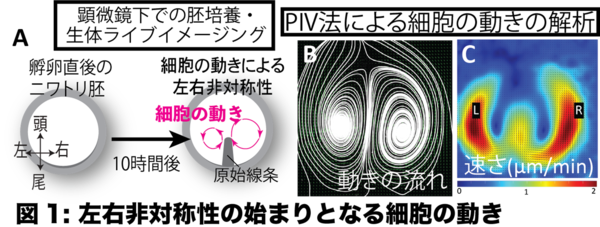- HOME
- News & Events
- Publications
- 【Publications】Bilateral cellular flows display asymmetry prior to left-right organizer formation in ...
Publications
【Publications】Bilateral cellular flows display asymmetry prior to left-right organizer formation in amniote gastrulation
February 14 2025
Lab: Rieko Asai
Paper information
Title:
Bilateral cellular flows display asymmetry prior to left-right organizer formation in amniote gastrulation
Rieko Asai, Sinha Shubham, Vivek N Prakash, Takashi Mikawa
Proceedings of the National Academy of Sciences (PNAS) Vol. 122, No. 6 February 3 2025 doi: https://doi.org/10.1073/pnas.2414860122
URL: https://www.pnas.org/doi/10.1073/pnas.2414860122
Highlights
- Although the LR-asymmetry body plan is ubiquitously observed in the animal kingdom, it remains elusive how and when symmetry breaking for internal organ patterning is programmed.
-
By using chick model combined with a biophysical quantification, a bilateral cellular flow during primitive streak formation displays left-right asymmetric patterns, suggesting that a tightly controlled program for left-right asymmetry in embryos is initiated much earlier than current thoughts.
-
These findings implicate that will may have important role(s) for LR-asymmetric body patterning
-
This study is an international collaboration with University of Miami and University of California, San Francisco
Abstract:
Most animals exhibit left-right (LR) symmetric appearance along the midline. Amniotes (e.g., humans, mouse, and birds) have asymmetric internal organs, which transition from LR-symmetry to asymmetry during embryonic development. Here, using chick embryos, we examined the initiation of LR symmetry breaking. Our biophysical approaches to quantify cellular flows inferred that LR symmetry breaking occurs before the formation of the node, a LR organizer, which serves as a signaling center for LR patterning-gene programs. Our work demonstrates that quantitative biophysical parameters can help unravel the initiation of LR symmetry breaking, suggesting an involvement of physical mechanisms in this critical biological patterning process.
Graphical abstract

